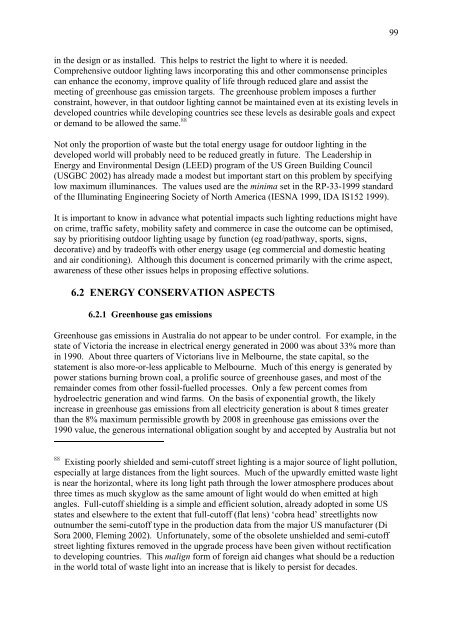Outdoor Lighting and Crime - Amper
Outdoor Lighting and Crime - Amper
Outdoor Lighting and Crime - Amper
You also want an ePaper? Increase the reach of your titles
YUMPU automatically turns print PDFs into web optimized ePapers that Google loves.
in the design or as installed. This helps to restrict the light to where it is needed.<br />
Comprehensive outdoor lighting laws incorporating this <strong>and</strong> other commonsense principles<br />
can enhance the economy, improve quality of life through reduced glare <strong>and</strong> assist the<br />
meeting of greenhouse gas emission targets. The greenhouse problem imposes a further<br />
constraint, however, in that outdoor lighting cannot be maintained even at its existing levels in<br />
developed countries while developing countries see these levels as desirable goals <strong>and</strong> expect<br />
or dem<strong>and</strong> to be allowed the same. 88<br />
Not only the proportion of waste but the total energy usage for outdoor lighting in the<br />
developed world will probably need to be reduced greatly in future. The Leadership in<br />
Energy <strong>and</strong> Environmental Design (LEED) program of the US Green Building Council<br />
(USGBC 2002) has already made a modest but important start on this problem by specifying<br />
low maximum illuminances. The values used are the minima set in the RP-33-1999 st<strong>and</strong>ard<br />
of the Illuminating Engineering Society of North America (IESNA 1999, IDA IS152 1999).<br />
It is important to know in advance what potential impacts such lighting reductions might have<br />
on crime, traffic safety, mobility safety <strong>and</strong> commerce in case the outcome can be optimised,<br />
say by prioritising outdoor lighting usage by function (eg road/pathway, sports, signs,<br />
decorative) <strong>and</strong> by tradeoffs with other energy usage (eg commercial <strong>and</strong> domestic heating<br />
<strong>and</strong> air conditioning). Although this document is concerned primarily with the crime aspect,<br />
awareness of these other issues helps in proposing effective solutions.<br />
6.2 ENERGY CONSERVATION ASPECTS<br />
6.2.1 Greenhouse gas emissions<br />
Greenhouse gas emissions in Australia do not appear to be under control. For example, in the<br />
state of Victoria the increase in electrical energy generated in 2000 was about 33% more than<br />
in 1990. About three quarters of Victorians live in Melbourne, the state capital, so the<br />
statement is also more-or-less applicable to Melbourne. Much of this energy is generated by<br />
power stations burning brown coal, a prolific source of greenhouse gases, <strong>and</strong> most of the<br />
remainder comes from other fossil-fuelled processes. Only a few percent comes from<br />
hydroelectric generation <strong>and</strong> wind farms. On the basis of exponential growth, the likely<br />
increase in greenhouse gas emissions from all electricity generation is about 8 times greater<br />
than the 8% maximum permissible growth by 2008 in greenhouse gas emissions over the<br />
1990 value, the generous international obligation sought by <strong>and</strong> accepted by Australia but not<br />
88 Existing poorly shielded <strong>and</strong> semi-cutoff street lighting is a major source of light pollution,<br />
especially at large distances from the light sources. Much of the upwardly emitted waste light<br />
is near the horizontal, where its long light path through the lower atmosphere produces about<br />
three times as much skyglow as the same amount of light would do when emitted at high<br />
angles. Full-cutoff shielding is a simple <strong>and</strong> efficient solution, already adopted in some US<br />
states <strong>and</strong> elsewhere to the extent that full-cutoff (flat lens) ‘cobra head’ streetlights now<br />
outnumber the semi-cutoff type in the production data from the major US manufacturer (Di<br />
Sora 2000, Fleming 2002). Unfortunately, some of the obsolete unshielded <strong>and</strong> semi-cutoff<br />
street lighting fixtures removed in the upgrade process have been given without rectification<br />
to developing countries. This malign form of foreign aid changes what should be a reduction<br />
in the world total of waste light into an increase that is likely to persist for decades.<br />
99
















